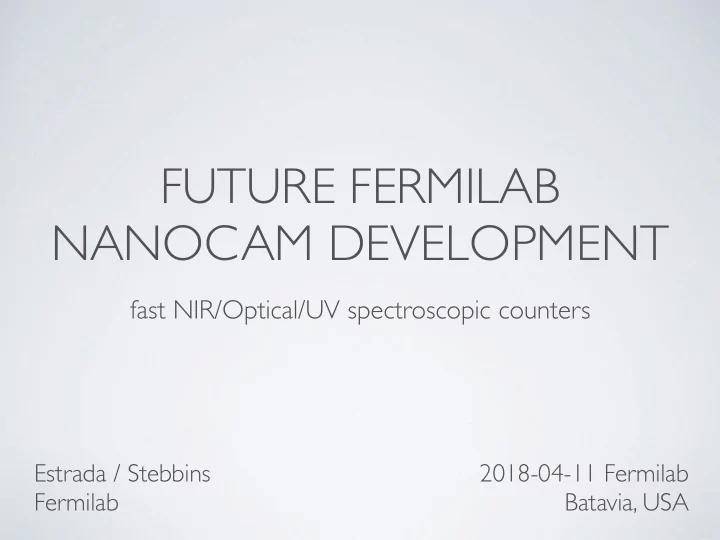

FUTURE FERMILAB NANOCAM DEVELOPMENT fast NIR/Optical/UV spectroscopic counters Estrada / Stebbins 2018-04-11 Fermilab Fermilab Batavia, USA
TECHNICAL MILESTONE: coherence GROUND BASED OPTICAL patches λ distance ∕ size x c ∕Δν IMAGING LIMITED BY EARTH SIZE : BASELINE ≲ 10000KM IN OPTICAL: WAVELENGTH ~ 1 MICRON ANGULAR SCALE ≳ 10 -9 ARCSEC correlations: amplitude ± intensity > 0 (net)
SCIENCE GOAL: IMAGE MATTER AS IT FALLS INTO BLACK HOLE HORIZON dots represent measured population of supermassive black holes lines represent sensitivity limit of technique using giant telescopes
SCIENCE GOAL: IMAGE EXPANDING EJECTA PRODUCED BY COALESCENCE OF NEUTRON STARS ORIGIN OF MOST HEAVY ELEMENTS IN THE UNIVERSE USE GRAVITY WAVES TO TRIGGER OBSERVATIONS
METHOD: SPECTROSCOPIC COUNT INTENSITY INTERFEROMETRY ���� � [ ��� � � ] μ � ���������� ���� / ��������� ����������� �� Broadband intensity correlations ----- δ � Δν = � / � ----- • intensity correlations convolution of spectra with itself: ��� ( δ I 2 ) ν = ¼ ∫ ⅆ ν ’ f ν ’ f ν - ν ’ • intensity “mixes” radiation field with itself ���� • 1% correlations at (measurable) 10psec timescale • much larger than field correlations ����� ���� ���� ���� ���� ���������� ���� � [ ������ � � ] μ � Spectroscopic (narrowband) intensity correlations ���������� ���� / ��������� ����������� �� • split light into narrow frequency channels ----- δ � Δν = � / � ----- • “mixes down” to 1/ δ t ~ Δ ν ��� • “mixes up” to 1/ δ t ~ 2 ν • at “quantum limit” δ t Δ ν ≲ ½ ⇒ R ~ ν / Δ ν ≳ 10 4 ���� • much easier to measure 50% correlations ����� • increases overall S/N by √ R ���� ���� ���� ���� ����������
ENABLING TECHNOLOGY Intensity interferometry measures the excess rate of “coincident” photon counts from a single source at two (or more) widely separated locations. Requires recording of vast numbers of photon arrival times. Ideally each photon should also have an accurate wavelength determination and precise and accurate time- of-arrival. • large collecting area telescopes (telescope) • high resolution (R~10 4 ) spectrograph to separate frequencies (spectrograph) • accurate times of arrival (timing) • precise times of arrival (fast counters) • detectors with large numbers of independent counters (pixelated counter)
HOW TO MEASURE INTENSITY CORRELATIONS One possible Possible Fermilab Role: camera design photon detector/counter concept: readout electronics integration of camera Record all photon time-of-arrivals at two telescopes For each frequency channel compute photon rate, r 1 & r 2, and rate of “coincident” arrivals r 12 timetag γ s { r 1 , r 2 , r 12 }
EXAMPLE DETECTOR: LAPPD? 25) Large Area Picosecond Photon Detector LAPPD could be centerpiece of fast spectroscopic counters • precise timing capability (<100psec) • >10 4 pixels for spectroscopy on each device • can handle large count rate (> million counts per second) • off-the-shelf technology soon? • Quantum Efficiency 20-40%? • Photo-cathodes have poor QE in NIR • better QE (esp. NIR) alternative: nanowire ��������������������������������������������������������������������� ������������������������������������������������������������������������������������������������� ��������������������������������������������������������������������������������� alternately, SiPM, SPAD, nanowire, … � ���������������������������� �������������������������������������������������������������������� ����������������������������������������������������������������������� ����� �������������������� ���������������� ������������������ ������ ��������������������������������������������������������������� ������������������������������������������������������������������� ��������������� �������������������������������������������� ���������������������������������������������������������������� ���������������������������������������������������������������������� ��������������������������������������������������������������������� ���������� � ������������������������������� ������������ � �������������������� ��������������������������������������������� � ����������������������������������������������������������������������������������������� � ����������������������������� � ������������������������������������������������������ � ��������������������
SIMULATED DATA mag 17 D = 30m T = 1sec n ch = 5000 mag 17 λ ∈ [ 300,800 ] nm D = 30m T = 1hr δ t = 10psec 400 2000 Φ self calibration simultaneous counts 300 1500 counts 200 1000 temporal alignment 100 500 0 0 300 400 500 600 700 800 - 1.0 - 0.5 0.0 0.5 1.0 λ ( nm ) time offset ( nsec ) mag 12.9 D 1 = 35m D 2 = 22m b ⊥ = 434km T = 4hr δ t = 10psec Q = 0.3 1 / ℓ = λ / ( 2 π b ⊥ ) • each camera is a moderate spectral resolution / 30 nas 50 nas 1.0 3C 273 Schwarzschild high very high time resolution spectro-photometer 3C 273 w/ E-ELT GMT 0.8 • temporal alignments removes 0.6 estimated Φ • tides / astrometric uncertainties / atmospheric refraction 3C 273 shadow 0.4 • coherence function is self-calibrated by counts 0.2 0.0 300 400 500 600 700 800 λ ( nm )
LARGE TELESCOPES WORLDWIDE LZT BTA LAMOST LBT2 Keck2 Hale GTC MMT Hobby-Eberly GeminiN Subaru effective aperture diameter ( meter ) TMT TMT VLT4 E - ELT 2025 2024 TMTb GMT 2025 2024 GeminiS E-ELT Keck2 1996 VLT4 Magellan2 SALT 2000 GTC HET 2008 1996 LBT Sub 2008 GemS SALT 2005 1998 2005 Mag2 2002 GemN LZT GMT LAMOST 1999 2003 2011 MMT BTA 1998 1975 Hale 1948 ordinal by collecting area APERTURE “DIAMETER” ≥ 200”
EXTREMELY LARGE TELESCOPES Giant Magellan Telescope (GMT) Thirty Meter Telescope (TMT) observing / co - observing 12 10 night duration ( hours ) E - ELT 8 E - ELT + GMT E - ELT + TMT1 E - ELT + TMT2 6 GMT canary islands GMT + TMT1 4 GMT + TMT2 hawaii TMT1 2 0 Jan Apr Jul Oct Jan European Extremely Large Telescope (E-ELT) time of year
SUMMARY • with technology that exists or will be available in next decade one is capable of decreasing best astronomical angular resolution to the nano-arc-second scale. • this can be done in the optical! • detector technology is what is already used in HEP • observational targets must emit enough radiation on these small angular scale: many of these targets black holes / neutron star coalescence are those of most interest for fundamental physics.
Recommend
More recommend